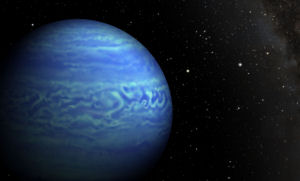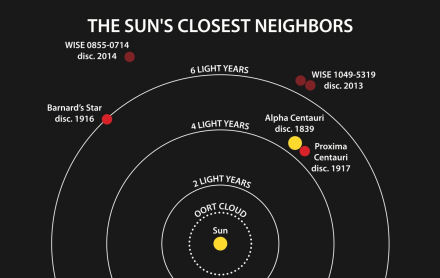28 April 2014
Newly discovered neighboring star as cold as the North Pole
by Will Parker
 Discovered using NASA's Wide-field Infrared Survey Explorer (WISE) and Spitzer Space Telescopes, a brown dwarf star only 7.2 light years distant appears to be the coldest of its kind - as chilly as Earth's North Pole.
Discovered using NASA's Wide-field Infrared Survey Explorer (WISE) and Spitzer Space Telescopes, a brown dwarf star only 7.2 light years distant appears to be the coldest of its kind - as chilly as Earth's North Pole.
"It is very exciting to discover a new neighbor of our solar system that is so close," said Kevin Luhman, an astrophysicist at Penn State. "In addition, its extreme temperature should tell us a lot about the atmospheres of planets, which often have similarly cold temperatures."
Brown dwarfs start their lives like normal stars, but they lack the mass to fuse nuclear fuel and radiate starlight. Luhman said the newfound brown dwarf, named WISE J085510.83-071442.5, is around 3 to 10 times the mass of Jupiter. If so, it is one of the least massive brown dwarfs yet discovered.
Luhman explained that WISE was able to spot the rare object because the telescope surveyed the entire sky twice in infrared light, observing some areas up to three times. "This object appeared to move really fast in the WISE data," he said. "That told us it was something special. The closer a body, the more it appears to move in images taken months apart. Airplanes are a good example of this effect: a closer, low-flying plane will appear to fly overhead more rapidly than a high-flying one."
After noticing the fast motion of WISE J085510.83-071442.5 in March, Luhman spent time analyzing additional images taken with Spitzer and the Gemini South telescope in Chile. Spitzer's infrared observations helped to determine the frosty temperature of the brown dwarf, estimated to be between -54 and 9 degrees Fahrenheit.
Combined detections from WISE and Spitzer, taken from different positions around the Sun, finally enabled the measurement of its distance through the parallax effect.

"It is remarkable that even after many decades of studying the sky, we still do not have a complete inventory of the Sun's nearest neighbors," said Michael Werner, the project scientist for Spitzer at NASA. "This exciting new result demonstrates the power of exploring the universe using new tools, such as the infrared eyes of WISE and Spitzer."
Related:
Discuss this article in our forum
Kepler mission identifies most Earth-like exoplanet yet discovered
Nearby star may have 3 habitable planets
Hubble identifies Earth-like debris in white dwarfs' atmospheres
Source: Penn State Center for Exoplanets and Habitable Worlds
